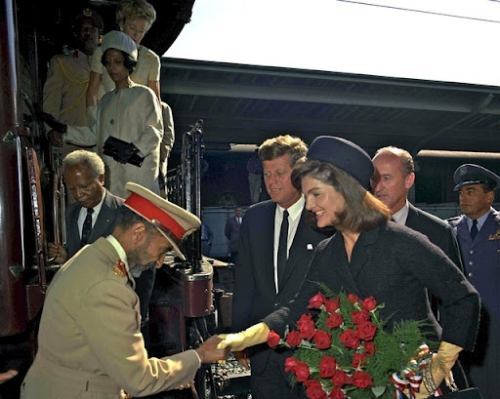Title : Emperor Haile Selassie I and United States
By UnionJah Observer | April 29, 2025
Haile Selassie I in the United States: The Emperor Walks Among Presidents
“Africa shall rise again — and stand as an equal at the table of nations.”
Multiple Visits, Historic Impact

Haile Selassie visited the United States several times, but two state visits stand out in historical significance:
First Visit: 1954
Purpose: Post-war diplomacy, Cold War alliances, economic development
Second Visit: 1963
Purpose: Speaking at the United Nations, civil rights solidarity, African Union vision
First Visit (1954): Standing Tall Among World Powers
- Haile Selassie was welcomed by President Dwight D. Eisenhower.
- His arrival symbolized Ethiopia’s survival after the brutal Italian invasion and its re-entry into global politics as a sovereign nation.
- A 21-gun salute, military honors, and formal ceremonies recognized him as a head of state among equals.
- Meetings with government officials focused on military cooperation, education exchange, and development support.
- He visited Howard University, a historic Black institution, reinforcing ties with African-American intellectuals and educators.
Second Visit (1963): Voice of Africa at the United Nations
Haile Selassie addressed the United Nations General Assembly in New York during a pivotal time — the height of the Cold War and the civil rights movement in America.
“Until the philosophy which holds one race superior and another inferior is finally and permanently discredited and abandoned… the dream of lasting peace and world citizenship will remain but a fleeting illusion.”
— Speech at the UN, October 4, 1963
This speech would later become the foundation of Bob Marley’s legendary song “War.”
His words pierced the conscience of the world, calling for racial equality, human rights, and African self-determination.
Civil Rights Era Context
Haile Selassie’s 1963 visit occurred during:
- The rise of Dr. Martin Luther King Jr.
- The March on Washington had just happened (August 1963)
- Malcolm X had spoken of the OAU and African liberation as global movements.
Many Black Americans saw Haile Selassie not just as a leader, but as a symbol of dignity, strength, and divine African royalty.

Symbolic Moments
- Laid a wreath at the Tomb of the Unknown Soldier in Arlington National Cemetery.
- Attended a White House state dinner hosted by President John F. Kennedy.
- Met with Black community leaders and academics, inspiring Pan-African unity.
Legacy in the U.S.
- Bob Marley’s “War” speech is based entirely on His Majesty’s words at the U.N.
- African Americans and Caribbean migrants saw Ethiopia not as distant, but as home.
- Inspired the Rastafari movement in North America.
- Helped define the United States’ vision of Africa as a partner, not a pawn in Cold War games.
Lasting Influence
Haile Selassie’s visits to the U.S. established:
- A diplomatic bond that benefited both nations.
- A spiritual awakening for African descendants.
- A political reminder that the voice of Africa would no longer be silenced on the global stage.


